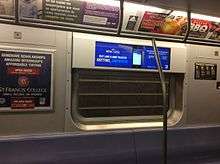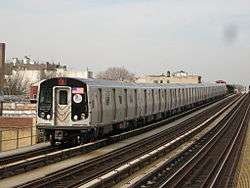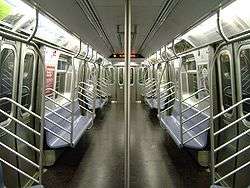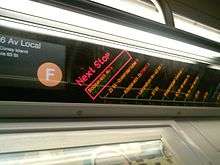R160 (New York City Subway car)
| R160A/R160B | |
|---|---|
|
An R160B train on the | |
|
| |
| In service | 2006-present |
| Manufacturer | Alstom, Kawasaki Heavy Industries |
| Family name | NTT (new technology train) |
| Replaced |
|
| Constructed | 2005-2010 |
| Entered service |
|
| Number built |
|
| Number in service | 1,662 (1,430 in revenue service during rush hours) |
| Formation |
93 four-car sets (two B cars) 258 five-car sets (three B cars) |
| Fleet numbers |
|
| Capacity |
54 seating 198 standing (A car) 56 seating 202 standing (B car) |
| Operator(s) | New York City Subway |
| Depot(s) |
207th Street Yard (92 cars) Coney Island Yard (570 cars) East New York Yard (280 cars) Jamaica Yard (720 cars)[1] |
| Service(s) assigned |
|
| Specifications | |
| Car body construction | Stainless steel with fiberglass ends and rear bonnets |
| Train length |
4-car train: 240.84 feet (73.41 m) 5-car train: 301.05 feet (91.76 m) 8-car train (two 4-car sets): 481.68 feet (146.82 m) 10-car train (two 5-car sets): 602.1 feet (183.5 m) |
| Car length | 60.21 feet (18.35 m) |
| Width | 9.77 feet (2,978 mm) |
| Height | 12.13 feet (3,697 mm) |
| Floor height | 3.76 ft (1.15 m) |
| Platform height | 3.76 ft (1.15 m) |
| Entry | 3.76 ft (1.15 m) |
| Doors | 8 per car |
| Maximum speed | 55 mph (89 km/h) |
| Weight | 85,200 lb (38,600 kg) |
| Traction system |
Alstom Onix IGBT AC traction motors, model: 4LCA1640A (8313-8842, 9103-9974) Siemens SITRAC IGBT AC traction motors (cars 8843-9102) |
| Prime mover(s) | electric motor |
| Power output |
147.5 hp (110 kW) to 150 hp (112 kW) per axle All axles motorized[2][3] |
| Acceleration | 2.5 mph/s (4.0 km/(h·s)) |
| Deceleration |
3.0 mph/s (4.8 km/(h·s)) (full service), 3.2 mph/s (5.1 km/(h·s)) (emergency) |
| Auxiliaries | SAFT 250AH battery (B car) |
| Electric system(s) | 600 V DC Third rail |
| Current collection method | Contact shoe |
| Braking system(s) | Dynamic braking propulsion system; WABCO RT-5 tread brake system |
| Safety system(s) | dead man's switch, tripcock |
| Headlight type | halogen light bulb |
| Track gauge | 1,435 mm (4 ft 8 1⁄2 in) standard gauge |
The R160 is a class of 1,662 new technology (NTT) New York City Subway cars built by Alstom Transportation and Kawasaki for the B Division. The cars replaced all R38s, R40/40As, and New York City Subway-operated R44s, as well as a majority of R32s and R42s.
Description
The R160A/R160B trains are externally similar to the older R143s but they are unable to operate as a single unit due to electrical incompatibilities. There are two versions of the R160: the R160A (built by Alstom, numbered 8313-8712, 9233-9802, & 9943-9974) and R160B (built by Kawasaki, numbered 8713-9232 & 9803-9942). The two car types are nearly identical to each other, and differ only in a few ways; it is possible for them to operate together as needed.
The R160 cars are configured in either four-car sets or five-car sets. 372 R160A cars (8313-8652 & 9943-9974) are configured as four-car sets. Most of the four-car trains are maintained at East New York Yard for the BMT Eastern Division (J/Z, L, and M); the others are maintained at the 207th Street Yard for the C. The remaining 630 R160A cars and all R160Bs are configured as five-car sets for use on IND and BMT main line services. Some are maintained at Jamaica Yard, typically operating on the E and F, and the rest are maintained at the Coney Island Yard, typically operating on the N, Q and W.
The R160A base order was part of a $961,687,121 contract funded in part by a grant from the Federal Transit Administration.[4] The primary base order of the R160 class consisted of 660 cars, 400 R160As to be built by Alstom, and the remaining 260 R160Bs to be built by Kawasaki. The contract included options for further orders, which, if exercised, would have brought total business with NYCT to about US$2.4 billion, for 1,700 subway cars, and Kawasaki would have manufactured 40% (680 cars) of the 1,700 cars. The R160 fleet was purchased at an average cost of $1.28 million USD per car.
Features
The R160 cars are equipped with the latest control system, HVAC and public address system to improve passenger comfort and safety. The R160s are very similar to the R143s, and the two car types can operate together in a mixed train in service.[5][6] The R160s are also visually very similar to the R179s, but the two car types are not interoperable with each other due to electrical incompatibilities between the two car types.[7]
One of the major changes and highlights of the new cars is the addition of an electronic "FIND" (Flexible Information and Notice Display) system, which includes an LCD screen displaying the route, route information and advertisements, and a tri-color (red, yellow, green) LED strip map which displays the next ten stations, plus five consecutive "further stops" to riders. There are three of these in every car. The display updates the stations at every stop, also giving the number of stops to each station listed. The FIND system replaces a plastic card which had a set route and stations printed on, which was used on the R142, R142A, R143, and R188 subway cars, each of which has 63 (001 thru 063) amber LED dots type station indicators. This allows for instant route or line changes with the correct information, which includes, but is not limited to, the omitting of certain stops.[5] The FIND displays are manufactured by KPS N.A., Inc., which is a division of Koito Industries. [8]
Both the R160As and R160Bs come with provisions for the future installation for CBTC. Currently, only 68 R160As (8313-8380) have been retrofitted with CBTC equipment for operation on the L route alongside trains of CBTC-equipped R143 cars.[9][10]
Experimental


R160As 9798-9802 have experimental looped stanchions with double poles in their center segments, instead of the typical single poles seen in other cars. These looped stanchions are meant to provide twice as many riders with poles to hold onto than in regular cars.
In June 2016, the MTA began installing Wi-Fi in four R160s assigned to the Jamaica Yard. In-car Wi-Fi was expanded to 20 R160s by September.[11] This pilot program was not advertised to passengers.[12] On the Wi-Fi enabled cars, colored stickers were placed above the number plates of each car. It is unclear which cars this test was performed on.
Also in 2016, the interiors of the electronic sign boxes on R160Bs 9023-9027 were retrofitted with LCD screens, replacing the MTA Arts for Transit cards that are usually located there. This is different from the FIND screens in that the new LCD screens are wider and can display advertisements, public safety announcements, and other information (the FIND screens can only display PSAs and the route designation). These screens are similar to the LED screens in the R143s, except that the R160 screens have the capabilities to display multiple colors instead of just red, orange, and green.[13] These LCD signs were later installed in other R160 cars, mainly the R160s assigned to Coney Island Yard.
In 2010, R160Bs 8713-8722 were experimentally retrofitted with folding seats, video recording devices, pivoted grab handles, and looped stanchions. This was part of a pilot program designed to maximize rush hour standing space and increase capacity by 19%, in addition to increasing security throughout the system.[14] However, due to several complaints from passengers and Kawasaki's refusal to retrofit an R142 with the same features, the pilot program was cancelled in 2012.[15][16] These cars had all of these features removed and their interiors reverted to the appearance of most other R160s.
Several sets have had their original fluorescent interior lights replaced with LED lights.
History
Construction
Kawasaki and Alstom organized a joint venture called Alskaw Inc. for project management, engineering and equipment purchasing to pursue the contract. The two companies built and delivered the rolling stock through the joint venture. Kawasaki not only manufactured 260 cars for the base contract, but was also the engineering leader for the whole project and provided the trucks for all cars. Alstom assembled 1,002 R160A cars at its manufacturing plant in Hornell, New York, while Kawasaki assembled 660 R160B cars at its plant in Yonkers, New York.[17] Shells for the Alstom-built cars were built in their Lapa plant, in São Paulo, Brazil, and shells for the Kawasaki-built cars were assembled at their Lincoln, Nebraska, plant. The base order consisted of 660 cars, the first option included 620 cars, and the second option included 382 cars.[18]
Delivery
Early on in the order, Alstom encountered significant start-up production problems since being awarded the base contract. In July 2005, Alstom missed its contractual deadline to deliver the 10-car test train, which arrived five months late with Alstom requesting three additional months to deliver the test train. In addition, the Transit Authority rejected several car shells made earlier at their plant in Lapa, Brazil, near São Paulo, after discovering welding defects.[19]
The first 5-car set of R160As (8653-8657) was delivered on November 29, 2005, and the next remaining five cars (8658-8662) were delivered on December 6, 2005 to the New York City Transit Authority, forming a complete 10-car train for acceptance testing and evaluation. The R160As entered revenue service on the A on October 17, 2006 for their 30-day acceptance test, after several months of exhaustive non-revenue service tests. The R160A train passed on November 16, 2006, concluding all testing for the R160As.
The first train of R160Bs (8713-8722) was delivered on July 22, 2005. The R160Bs entered revenue service on the N on August 17, 2006 for their 30-day acceptance test, after slightly over a year of successful non-revenue service tests.[20] This train was then transferred to the A on August 20 to continue with its 30-day performance test. The R160B train passed on September 30, 2006, concluding all testing for the R160Bs.
While Kawasaki had no problems in delivering the R160Bs, Alstom was behind on its delivery schedule early on in the R160A order. Alstom was to deliver 200 out of the 400-car base order by September 2007. However, by that month, Alstom had only delivered 80 cars.[21] Under the base contract, Alstom agreed to pay damages of $800 a day for late deliveries of four-car trains, and $1,000 a day for five-car trains, though the Transit Authority had not yet fined Alstom for its late deliveries and was actually negotiating with Alstom to accelerate their delivery schedule. The 200 cars were finally delivered 7 months late in early April 2008.
On November 10, 2008, the MTA exercised options for 140 R160B cars (9803-9942), and 242 R160A cars, broken down into 32 cars arranged as 4-car sets (9943-9974) and 210 cars arranged in 5-car sets (9593-9802).[22][23] The final cars were delivered on May 6, 2010.[18] The option order cars were delivered starting in late 2009, and by June 2010, all of the R160 cars were in revenue service.
Post-delivery
After Hurricane Sandy, R160B set 8738–8742 was damaged and required an extensive electrical reconstruction at Coney Island Shops. In March 2016, the set underwent pre-service testing and finally returned to service in fall 2016.[24]
In the summers of 2013 and 2014, some four-car R160A sets were temporarily assigned to the C due to passenger complaints, regarding the reliability and quality issues with the R32s on that route. By May 2015, more than half of the C's fleet was permanently assigned with R160As, leading to more reliable service along that route.[25]
R160As 8313–8316 and 8377–8380 had new CBTC equipment installed were set up as a test train as specifications were being developed for the future installation of CBTC on the IND Queens Boulevard Line. The train could be found on the IND Culver Line express tracks between Bergen Street and Church Avenue, which have been set up to test CBTC.[26] The cars have since returned to service.
See also
- New Technology Train - A list of all NTT trains on the New York City Subway.
- R143 (New York City Subway car) - a similar car also built by Kawasaki Railcar Corp. of Kobe, Japan
- R179 (New York City Subway car) - a similar car currently being built by Bombardier Transportation.
References
- ↑ New York Subway Barn Assignments – November 6, 2016
- ↑ Hughes, Murray (January 1, 2003). "Subway contract won with help from Brazil". Railway Gazette International.
- ↑ "CIYT201122.jpg Photo by mediccjh | Photobucket". Smg.photobucket.com. Retrieved August 19, 2013.
- ↑ "MTA - Press Release - MTA Headquarters - MTA NYC Transit Awards New Car Contract". mta.info.
- 1 2 Chan, Sewell (November 30, 2005). "New Subway Cars Promise All Kinds of Information". The New York Times. Retrieved October 27, 2007.
- ↑ "Specifications for Furnishing and Delivering Passenger Cars for the New York City Transit System" (PDF). geniustransitchallenge.ny.gov. July 2017. p. R160 1-2. Retrieved August 6, 2017.
- ↑ "Transit & Bus Committee Meeting May 2016" (PDF). mta.info. Metropolitan Transportation Authority. May 2016. Retrieved September 10, 2016.
- ↑ http://kpsna.com/products.html
- ↑ "Volume 2, Part 3 - November 2008 MTA Financial Plan: Section IV-3 and section IV-12" (PDF). Metropolitan Transportation Authority. Retrieved July 19, 2016.
- ↑ "Capital Program Oversight Committee Meeting June 2011" (PDF). mta.info. Metropolitan Transportation Authority. June 27, 2011. Archived from the original (PDF) on August 17, 2014. Retrieved September 11, 2016.
- ↑ Hawkins, Andrew J . (June 2, 2016). "The MTA is testing Wi-Fi inside its subway cars". The Verge. Retrieved September 17, 2016.
- ↑ Martinez, Jose (June 1, 2016). "Exclusive: MTA Quietly Begins Testing Wi-Fi Service in Subway Cars". TWC News. Retrieved September 17, 2016.
- ↑ Dj Hammers (November 7, 2016). ⁴ᴷ R160B LCD Side Sign Test Train. YouTube. Retrieved November 7, 2016.
- ↑ "Camera- and flip seat-equipped train debuts on E". Second Ave. Sagas. February 22, 2010. Retrieved October 19, 2016.
- ↑ "Transit scraps flip-seat pilot but other tests go on". Second Ave. Sagas. August 27, 2010. Retrieved January 5, 2017.
- ↑ "Seatless train experiment stalling out". Second Ave. Sagas. September 21, 2009. Retrieved January 5, 2017.
- ↑ MTA Press Release #24 2002
- 1 2 "Capital Program Oversight Committee Meeting February 2012" (PDF). mta.info. Metropolitan Transportation Authority. February 27, 2012. Archived from the original on August 17, 2014. Retrieved September 11, 2016.
- ↑ Chan, Sewell (July 27, 2005). "Damaged Cars Hinder New York's Order for New Subways". New York Times. Retrieved August 30, 2009.
- ↑ Lueck, Thomas J. (August 18, 2006). "City Subways Put New Cars Into Service as a Test Run". The New York Times. Retrieved January 24, 2016.
- ↑ Golding, Bruce (September 30, 2007). "Train-Car Builder is Off Track". New York Post. Retrieved August 30, 2009.
- ↑ "MTA Capital Program Commitments & Completions through December 31, 2010" (PDF). mta.info. Metropolitan Transportation Authority. January 24, 2011. Archived from the original on August 17, 2014. Retrieved September 11, 2016.
- ↑ "Alstom to supply an additional 242 subway cars to New York City". alstom.com. November 10, 2008. Archived from the original on February 5, 2009.
- ↑ "New York City Subway Car Update" (PDF). The Bulletin. Electric Railroaders' Association (April 2016). March 30, 2016. Retrieved March 30, 2016.
- ↑ "Review of the A and C Lines" (PDF). Metropolitan Transportation Authority. December 11, 2015. Retrieved January 19, 2016.
- ↑ "New York City Subway Car Update" (PDF). The Bulletin. Electric Railroaders' Association (April 2016). March 30, 2016. Retrieved March 30, 2016.
External links
| Wikimedia Commons has media related to R160 (New York City Subway car). |
- nycsubway.org: R160 cars
- BMT-IND Car Assignments – January 1, 2017
- New York City Subway Car Fleet June 2010 through November 2016
- National Geographic video about Alstom's manufacturing of the R160A car on YouTube
- Kawasaki Rail Car, Inc.: R160B





